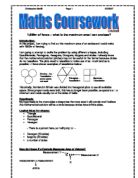Christopher Morfill Page 5/2/2007
1,000m of fence – what is the maximum area I can enclose?
Introduction:
In this project, I am trying to find out the maximum area of an enclosure I could make with 1000m of fencing.
I am going to attempt to tackle the problem by using different shapes, Including Quadrilaterals, Pentagons, Hexagons, Octogons, Isogons and circles. I already know that the mathematical solution (circles) may not be useful for the farmer because circles do not tessellate. The plots need to tessellate to make use of as much land as is possible – I have shown examples of tessellation below:
Historically, farmland in Britain was divided into hexagonal plots to use all available space. Since proper roads were built, this has no longer been possible, as space is at a minimum and roads usually run at the sides of fields.
Hypothesis:
My hypothesis is the more sides a shape has the more area it will contain and I believe the mathematical solution will be a circle because circles have infinite sides.
Logical Ideas for shapes:
- Triangle
- Quadrilateral
- Pentagon
- Hexagon
- There is a pattern here, so I will jump to: - - Decagon (10 sides)
- Isogons (20 sides)
- n number of sides
How do I know if a Formula Measures Area or Volume?
½ b h
measurement x measurement
l b w
measurement x measurement x measurement
Quadrilateral:
As with triangles, there are different types of quadrilaterals to consider: Rectangle, Square, Parallelogram, Trapezium, Rhombus and Kite. Quadrilaterals all follow the same basic rules – each quadrilateral has 4 sides and 4 sides only, and opposite sides are equal (parallel)
Squares and rectangles also follow two more rules: The sum of all the angles added together must equal 360º, and each corner angle must be 90º. Because I am investigating quadrilaterals and rectangles in particular, I automatically investigate squares.







